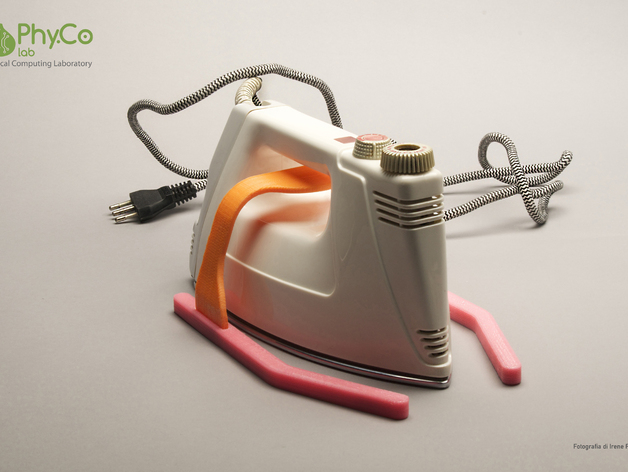
Guida per ferro da stiro per non vedenti
thingiverse
Guida per ferro da stiro per non vedenti - Accessorio per stirare senza rischi di ustioni -- Questo oggetto è stato sviluppato da PhyCoLab in occasione del workshop "Progetti al Buio - Soluzioni auto producibili per problemi invisibili" Per maggiori informazioni vedi la sezione "Istruzioni" For more informations see the "Instructions" tab Phy.Co Lab - Physical Computing Laboratory Instructions Progetti al Buio == Soluzioni auto producibili per problemi invisibili Grazie alla diffusione delle stampanti 3D e le macchine di fabbricazione digitali da scrivania, gli utenti hanno la possibilità di personalizzare gli oggetti secondo le proprie necessità. I Designer non hanno più la necessità di adottare un approccio "Design for All": ogni prodotto può essere modificato a seconda delle proprie necessità prima di essere prodotto, riducendo costi e coinvolgendo l'utente nell'atto creativo. In occasione della Milano Design Week 2014, 8 designers coordinati da Maximiliano Romero del Laboratorio di Physical Computing del Dipartimento Design del Politecnico di Milano, e 4 utenti non vedenti hanno lavorato in team per disegnare prodotti di uso quotidiano da stampare in sito. A conclusione del workshop, i modelli risultanti sono stati caricati in una piattaforma on-line dedicata e resi disponibili al pubblico, non vedente e non, di tutto il mondo. Design in the Dark === DIY solutions to invisible problems With the diffusion of 3D printers and digital desktop fabrication technologies users have gained the power to customize objects to their own requirements and needs. Designers no longer need to adopt a "Design for All" strategy: every device can be adjusted to the user specific needs before production, reducing costs and engaging the consumer in the creative act. 3D printers are still new in the consumer market, but they have huge potential to help the blind and visually impaired, granting them access to items designed for their specific needs and enabling them to touch volumes, shapes and textures of objects they wouldn't otherwise have been able to experience. Internet enables users to share their designs and every day new items become available on the web. During the Milan Design Week 2014, 8 designers, coordinated by Maximiliano Romero from the Physical Computing Laboratory of the Design Department of the Politecnico of Milano, and 4 blind users has worked in teams to design everyday objects meant to be printed in loco. At the end of the workshop the resulting items has been uploaded on a dedicated online platform to be downloaded, customized and printed all around the world. Credits: Phy.Co Lab - Physical Computing Laboratory Associazione Lavoro e Integrazione ONLUS Responsabile: Maximiliano Romero Coordinamento Generale: Marta Zambelli, Maicol Zoia, Giulia Tognali, Irene Fedrigo, Irene Gussoni. Phycolab Team Designers: Valentina Gigante Chiara Capuzzo Giulia Agatea Marco Giorio Tommaso Miti Andrea Brivio Ksenia Rogacheva Utenti co-progettisti: Analisa Risola Manuele Bravi Arianna Orlando Giulia Pagoni Federico Zonca (Happy Vision) Greta Carrara Simone Natalizio. Supporto tecnico: Magut Design, Ludovico Guazzetti. Partner tecnici: Futura Group (stampanti 3DRAG), Bitek Srl. (stampanti STRATO) Servizio Fotografico: Lorenzo Berni per LabFoto dipartimento del Design (Altre fotografie del LabFoto sono reperibili qui). Fotografia Prodotti: Irene Fedrigo Rassegna stampa: Articolo Corriere della Sera
With this file you will be able to print Guida per ferro da stiro per non vedenti with your 3D printer. Click on the button and save the file on your computer to work, edit or customize your design. You can also find more 3D designs for printers on Guida per ferro da stiro per non vedenti.
